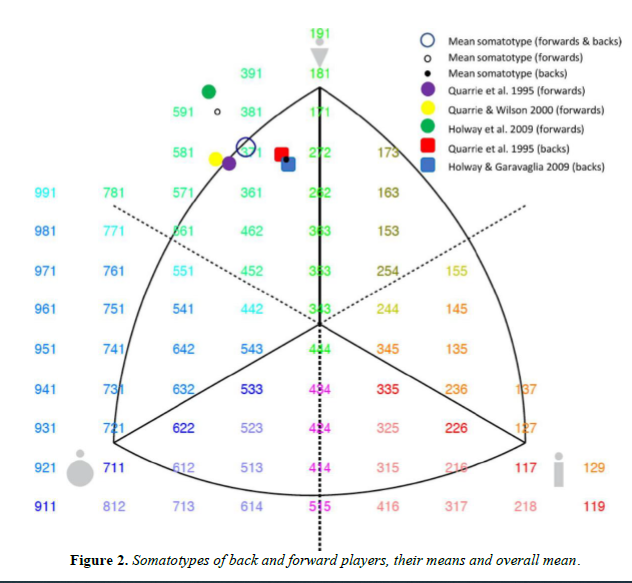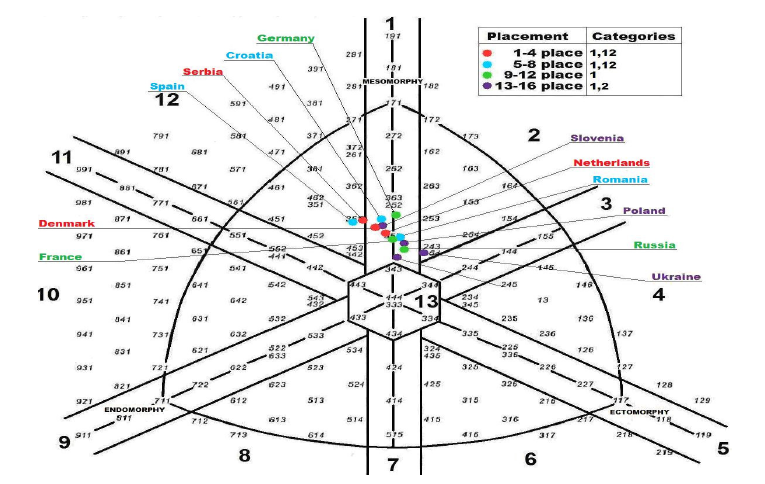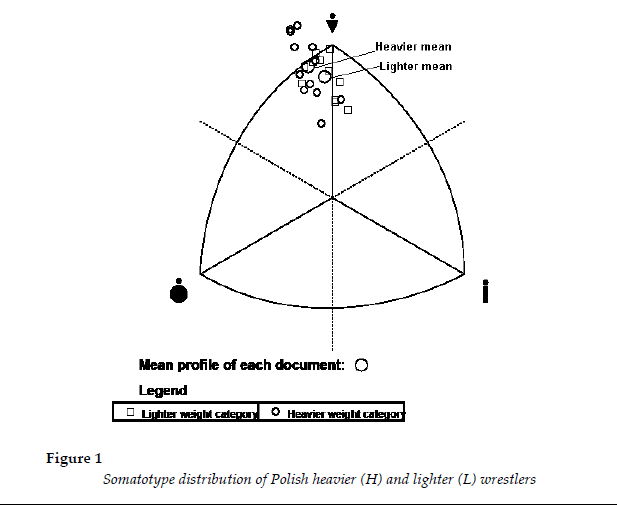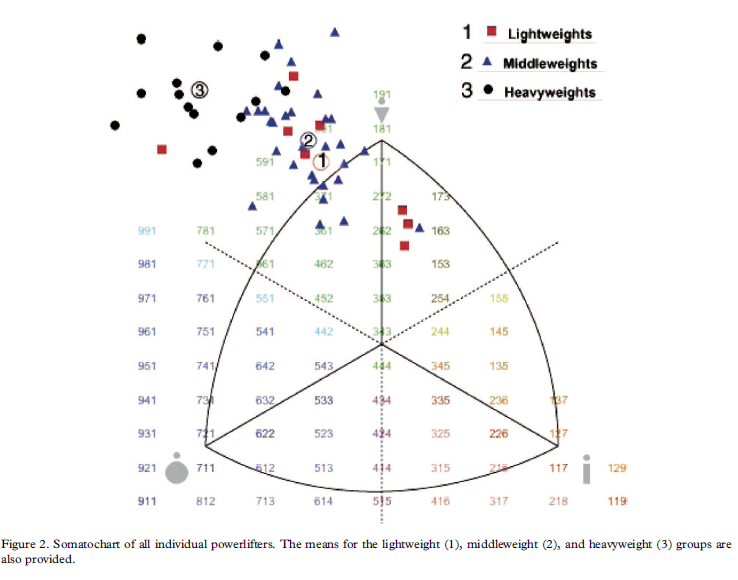SOMATOTYPE
Before taking the test, you will need a body mass scale, stadiometer, body fat caliper, measuring tape, and breadth caliper.
Note: the validity of the rating depends on the reliability of the measurements used. If you want accurate results, then stature and girths should read to the nearest mm, biepicondylar diameters to the nearest 0.5 mm, and skinfolds to the nearest 0.1 mm (Harpenden caliper) or 0.5 mm on other calipers. Take 3 attempts for each measurement.
- Stature. Taken against a height scale or stadiometer. Take height with the subject standing straight, against an upright wall or stadiometer, touching the wall with heels, buttocks and back. Orient the head in the Frankfort plane (the upper border of the ear opening and the lower border of the eye socket on a horizontal line), and the heels together. Instruct the subject to stretch upward and to take and hold a full breath. Lower the headboard until it firmly touches the vertex.
- Bodyweight. The subject, wearing minimal clothing, stands in the center of the scale platform. Record weight to the nearest tenth of a kilogram. A correction is made for clothing so that nude weight is used in subsequent calculations.
-
Skinfolds. Raise a fold of skin and subcutaneous tissue firmly between thumb and forefinger of
the left hand and away from the underlying muscle at the marked site. Apply the edge of the plates on
the caliper branches 1 cm below the fingers of the left hand and allow them to exert their full pressure
before reading at 2 sec the thickness of the fold. Take all skinfolds on the right side of the body. The
subject stands relaxed, except for the calf skinfold, which is taken with the subject seated.
- Triceps skinfold. With the subject's arm hanging loosely in the anatomical position, raise a fold at the back of the arm at a level halfway on a line connecting the acromion and the olecranon processes.
- Supraspinale skinfold. Raise the fold 5-7 cm (depending on the size of the subject) above the anterior superior iliac spine on a line to the anterior axillary border and on a diagonal line going downwards and medially at 45 degrees. (This skinfold was formerly called suprailiac, or anterior suprailiac. The name has been changed to distinguish it from other skinfolds called "suprailiac", but taken at different locations.)
- Medial calf skinfold. Raise a vertical skinfold on the medial side of the leg, at the level of the maximum girth of the calf.
-
Bone breadth measurments.
- Biepicondylar breadth of the humerus, right. The width between the medial and lateral epicondyles of the humerus, with the shoulder and elbow flexed to 90 degrees. Apply the caliper at an angle approximately bisecting the angle of the elbow. Place firm pressure on the crossbars in order to compress the subcutaneous tissue.
- Biepicondylar breadth of the femur, right. Seat the subject with knee bent at a right angle. Measure the greatest distance between the lateral and medial epicondyles of the femur with firm pressure on the crossbars in order to compress the subcutaneous tissue.
-
Limb circumference measurments.
- Calf girth, right. Stand with feet slightly apart. Place the tape around the calf and measure the maximum circumference
- Upper arm girth, elbow flexed and tensed, right. The subject flexes the shoulder to 90 degrees and the elbow to 45 degrees, clenches the hand, and maximally contracts the elbow flexors and extensors. Take the measurement at the greatest girth of the arm.
Scale and Stadiometer
This tool will measure your bodyweight to the gram and height to the mm precision.
BUY NOWCarter, J. (2002) 'Part 1: The Heath-Carter anthropometric somatotype-instruction manual', From htth/cmvwsomatotypeorg/Heath—CarterManual. pdf [Retrieved 31 Janu-uary 2013], pp. 3-4.
Darrall-Jones, J. D., Jones, B. and Till, K. (2015) 'Anthropometric and Physical Profiles of English Academy Rugby Union Players', Journal of Strength and Conditioning Research, 29(8), pp. 2086-2096.
Huygens, W., Claessens, A. L., Thomis, M., Loos, R., Van Langendonck, L., Peeters, M., Philippaerts, R., Meynaerts, E., Vlietinck, R. and Beunen, G. (2002) 'Body composition estimations by BIA versus anthropometric equations in body builders and other power athletes', The Journal of Sports Medicine and Physical Fitness, 42(1), pp. 45-55.
Keogh, J. W. L., Hume, P. A., Pearson, S. N. and Mellow, P. (2007) 'Anthropometric dimensions of male powerlifters of varying body mass', Journal of Sports Sciences, 25(12), pp. 1365-1376.
Pritchett, R. C., Thornley, T. T., Pritchett, K. L. and Green, M. J. (2017) 'Physiological & Anthropometric Profiles Of Elite Collegiate Rugby Union Players', Medicine & Science in Sports & Exercise, 49, pp. 733.
Scanlan, J. M., Ballmann, K. L., Mayhew, J. L. and Lantz, C. D. (1999) 'Anthropometric dimensions to predict 1-RM bench press in untrained females', The Journal of Sports Medicine And Physical Fitness, 39(1), pp. 54-60.
Sterkowicz-Przybycie, K. L., Sterkowicz (2011) 'Somatotype, Body Composition and Proportionality in Polish Top Greco-Roman Wrestlers', Journal of Human Kinetics, 28(1), pp. 141-154.
Stoop, R., Hohenauer, E., Rucker, A. M. L. and Clijsen, R. (2018) 'Anthropometric Properties versus Physical Performance in Rugby Union Forwards and Backs-A Systematic Review', Annals of Applied Sport Science, 6(2), pp. 01-13.
URBAN, F., KANDRÁČ, R. and TÁBORSKÝ, F. (2011) 'Anthropometric and Somatotype Profiles of the National Teams at the 2011 Women's 19 European Handball Championship', EHF Web Periodical.
- Ectomorphy can be changed from your height to weight ratio.
- Mesomorphy can be changed from your bone breadth, height, and limb circumference.
- Endomorphy can be changed from your body fat to height ratio.







